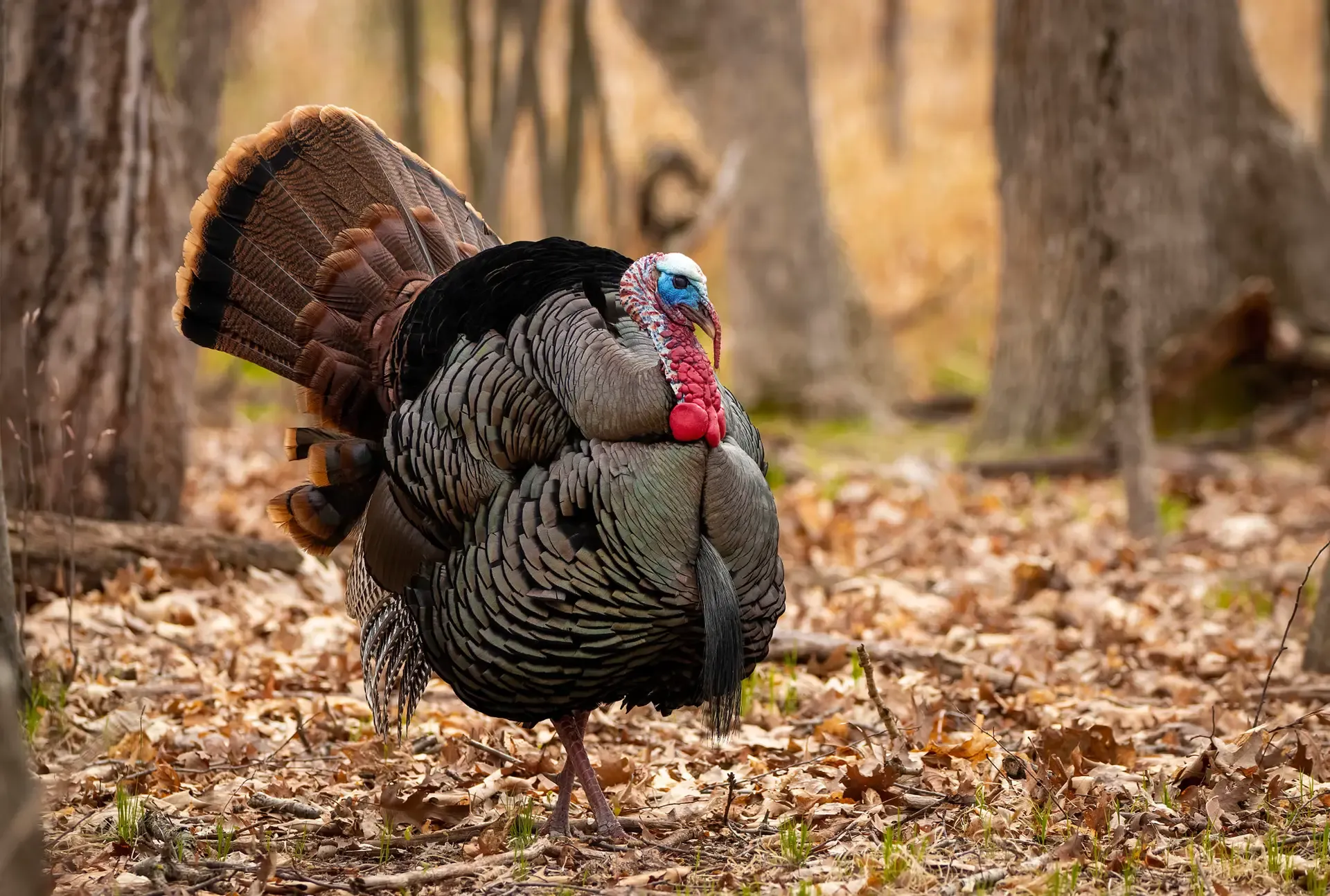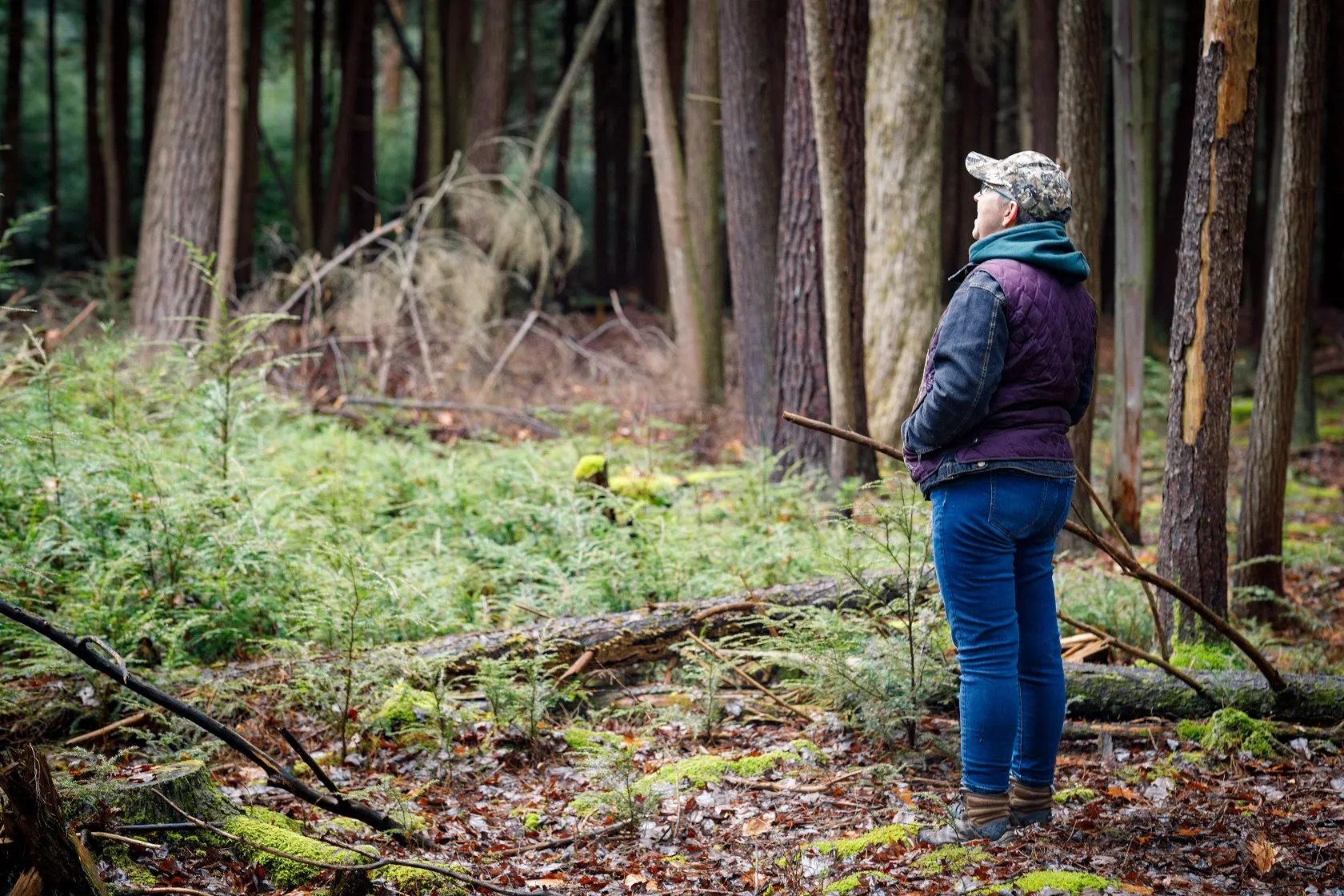6 Ways to Attract Turkey to Your Woodlands

A wild turkey stands in the fall foliage. Male turkey are recognized by their large size, their colorful face, and distinctive, fanned plumage.
The wild turkey has a firm hold on the American imagination, tethering us to the past and symbolizing a season of plenty.
While habitat restoration has helped the wild turkey population rebound from 30,000 birds in the 1920s, an all-time low, to nearly 7 million in recent years, our feathered friends may not be out of the woods yet. Doing what you can to help improve turkey habitat and attract more of this species to your land is never a bad idea.
Meet the Wild Turkey
Wild turkey are cautious birds. They can run up to 25 miles per hour, fly 50 miles per hour, and make distinct calls to warn others in their flock of danger. These skills definitely make them hard for predators, such as coyote, cougar, and humans, to hunt. Turkey populations tend to fluctuate over time, making this shy species a challenge to manage.
How To Provide Good Turkey Habitat
Food
Turkeys love to eat young, tender, green grasses and forbs. They also enjoy fruit, nuts, and insects when they are available. Outside of the forest, these birds also eat grain from farm fields.
Cover
Although turkeys use tall hardwood forests for cover and roosting, they also like open and brushy areas for feeding, mating, nesting and rearing their young. This bird is dependent on a mix of open fields, pasture and forested land for their survival.
Water
Turkeys need water daily, so hens rarely nest far from a reliable water source such as a creek, spring, seep, or pond.
Space
A good quality habitat will support one bird per 30 acres, or one flock per 640 to 800 acres). Because turkeys need a lot of living space, they may not remain on your property year-round if you do not own their full range.

Female turkey walk across a woodland clearing. Females are recognized by their smaller plumage and size. Fun Fact: Females of the species are unable to make the distinctive turkey gobbling sound.
6 Ways to Help Turkeys in Your Woods
The following woodland management activities can help to meet the special needs of wild turkeys:
1. Disturbing the soil through shallow tillage, also known as "discing” stimulates the growth of highly nutritious forage, including native grasses and forbs.
2. Mowing should go hand-in-hand with discing. Concentrate on edge roads, fire breaks and old fields to remove old-growth grasses and disperse the seeds.
3. You can harvest specific stands in your forests, leaving other stands to flourish. The best stands for turkey are mature, mast-producing and roosting trees. Work with a forester to identify the best stands to trim in order to attract wildlife. You can also thin the forest understory. Turkeys prefer an open forest floor covered in leaflitter for easy forage. An open forest is also better for nesting and brood-rearing.
4. Removing undesirable trees, cultivating desirable ones and planting mast-producing trees can all help nourish and attract wildlife. Ideally, 20 to 30 percent of your woodland should consist of these fruit- and nut-bearing trees. Turkeys love acorns and pecans, as well as dogwoods, huckleberries, blueberries, and other fruits found in the understory.
5. Food plots can also be used to increase turkey sightings and harvest success. Food plots should be near a mature wooded area where turkeys roost and forage for mast. Soybean and corn are good choices because they provide food for wild turkey in winter. Some other specialized crops and turkey-friendly seed mixes can be purchased from suppliers like the National Wild Turkey Federation (NWTF). Be sure to check with a local professional first so you don't end up planting something that is considered non-native weeds in your state. Plant a food plot for every 25 acres of timber on your property. Plots should be one-half to two acres in size.
6. Springs and seeps are an important component of turkey habitat and will not only provide water for wild turkey but also attract insects and water for plants in warm months. In arid areas, developing water catchments, improving riparian habitat, and installing water guzzlers are good ways to ensure your local flock has adequate water supply.
Managing your property to increase forest health also provides a healthy habitat for wild turkey and other wildlife. Thoughtful action and appreciation of your woodland’s ecosystem will yield a more resilient and enjoyable forest for you and future generations.
To find out how you can improve the health of your forest with payments and help from a forester to implement a sustainable forest management plan, learn about the Family Forest Carbon Program.
Related Articles

December 18, 2025
Improving Wildlife Habitat with the Family Forest Carbon Program
For many landowners, spotting a fox, songbird, or other wildlife on their property is one of the highlights of spending time on their land. In this post we look at some examples of management practices you may see in your FFCP forest management plan and how they help create the ideal conditions for certain wildlife species.

December 16, 2025
Family Forest Carbon Program's First Ever Credits Delivered to REI Co-op
Today, REI becomes the first buyer to receive carbon credits from the Family Forest Carbon Program (FFCP), a high-integrity forest carbon project designed for small-acreage landowners.

December 4, 2025
Forest Carbon Project Issued First Ever Credits
Conservation organizations the American Forest Foundation (AFF) and The Nature Conservancy (TNC) announced today the issuance of improved forest management (IFM) carbon credits to the Family Forest Carbon Program (FFCP) from standards setter Verra under its Verified Carbon Standard (VCS) Program. This marks the first issuance of credits produced using Verra’s VM0045 improved forest management (IFM) methodology, which was co-developed by Verra, AFF, TNC, and TerraCarbon.